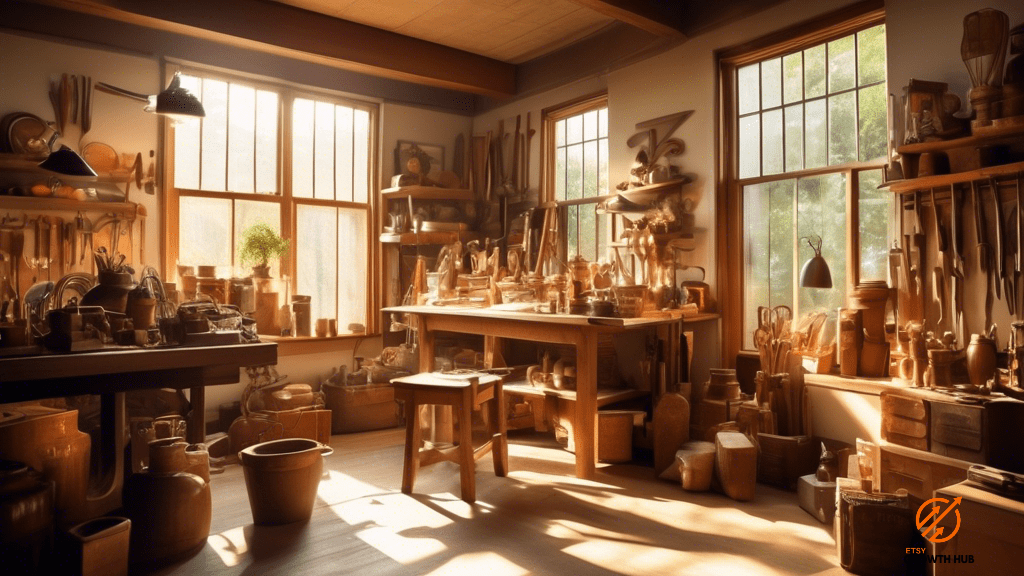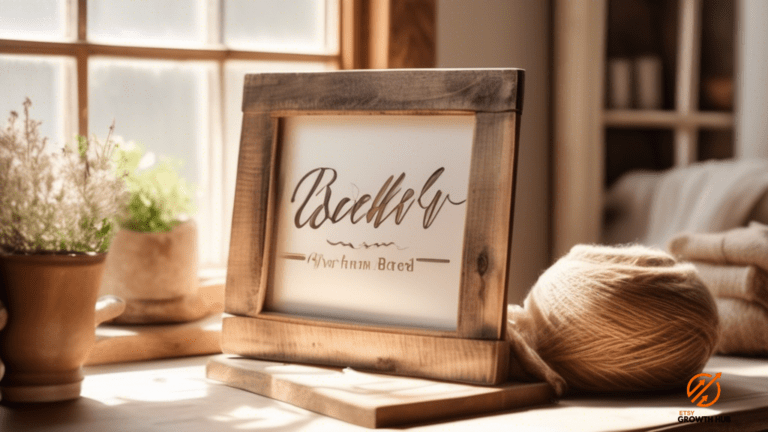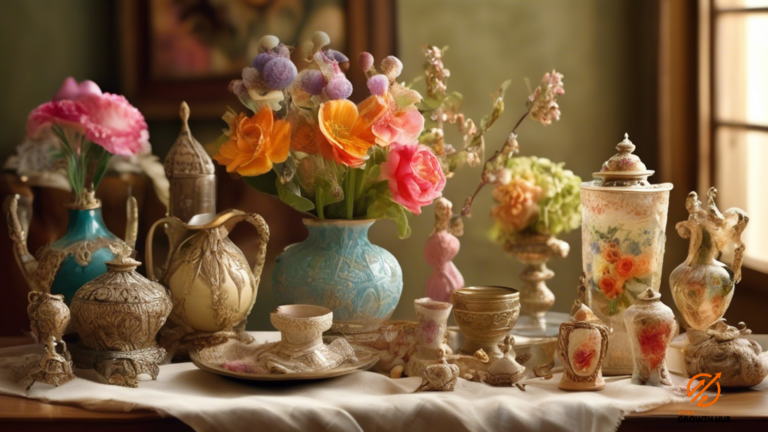Are you a vintage enthusiast with a knack for creating handmade treasures? Do you often find yourself wondering how to price your one-of-a-kind pieces to ensure both profitability and customer satisfaction? Look no further! In this article, we will delve into the world of strategies for pricing your handmade vintage items.
Imagine stepping into a cozy vintage shop, filled with the nostalgic scent of old books and the soft glow of antique lamps. The shelves are adorned with unique, handcrafted treasures, each one telling a story of its own. As a seller of vintage items, you have the power to create this same magical experience for your customers. But how do you determine the perfect price for your handmade creations? This article will guide you through the process, from researching market trends and evaluating the quality of your items to considering production costs and pricing competitively. With these strategies, you’ll be able to find the sweet spot that balances profitability and customer satisfaction, ensuring your vintage items find their perfect homes.
Key Takeaways
- Research market trends and demand for vintage items to accurately price them.
- Analyze sales data on platforms like Etsy or eBay to identify popular vintage items and their prices.
- Stay informed about current fashion and design trends to determine which vintage items are in demand.
- Evaluate the quality and rarity of handmade vintage items to accurately price them.
Researching Market Trends and Demand
When researching market trends and demand, it’s crucial to stay updated on the latest buying patterns and preferences in order to accurately price your handmade vintage items. By keeping a pulse on the market, you can identify which items are currently in high demand and adjust your pricing accordingly.
This involves researching popular vintage trends, browsing online marketplaces, and attending vintage fairs or events to see what items are selling well.
One effective way to research market trends is by analyzing sales data on platforms like Etsy or eBay. Look for patterns in what types of vintage items are consistently selling at higher prices and which ones are not moving as quickly. This will give you a good indication of what buyers are willing to pay for certain items. Additionally, pay attention to any customer reviews or feedback to see if there are any specific features or qualities that buyers value in vintage items.
Another important aspect of researching market trends and demand is staying informed about current fashion and design trends. Vintage items often go hand in hand with current fashion trends, as people look for unique and one-of-a-kind pieces to incorporate into their style. Keep an eye on fashion magazines, social media influencers, and popular fashion blogs to see what styles are currently popular. This will help you identify which vintage items are more likely to be in demand and can be priced accordingly.
By staying updated on the latest buying patterns and preferences, you can accurately price your handmade vintage items and increase your chances of selling them successfully.
Evaluating the Quality and Rarity of Your Items
To accurately assess the value of your unique creations, it’s essential to thoroughly evaluate the quality and rarity of each piece. When it comes to quality, consider the materials used, the level of craftsmanship, and the overall condition of the item.
High-quality materials such as sterling silver or genuine gemstones can significantly increase the value of your handmade vintage pieces. Additionally, items that showcase exceptional craftsmanship, such as intricate beading or hand-stitched details, are often considered more valuable. It’s important to carefully inspect each item for any signs of damage or wear, as this can affect its overall quality and therefore its pricing.
In addition to quality, rarity plays a crucial role in determining the value of your handmade vintage items. Rarity can be determined by factors such as the age of the item, the limited availability of similar pieces, or any unique characteristics that set it apart from others.
For example, if you have a vintage dress from a well-known designer that is no longer in production, it would be considered rare and therefore more valuable. Similarly, if you have a piece that features a unique pattern or color scheme that is not commonly found in similar items, it can also increase its rarity and value.
By thoroughly evaluating the quality and rarity of your handmade vintage items, you can ensure that you are pricing them accurately and maximizing their worth in the market.
Considering Production Costs and Time Investment
Take into account the effort and resources you put into creating your one-of-a-kind pieces so that you can accurately value and appreciate your craftsmanship. Pricing your handmade vintage items should not only cover the cost of materials, but also consider the time and skill invested in each piece.
Here are some factors to consider when evaluating the production costs and time investment:
- Time: Consider the number of hours it takes to create each item. Take into account not only the time spent on the actual creation, but also any time spent on research, design, and finishing touches.
- Skill level: Factor in your level of expertise and the skill required to create the item. If it requires advanced techniques or specialized knowledge, it may be worth pricing higher.
- Materials: Take into account the cost of materials used, including any rare or unique materials that may have been sourced.
- Overhead expenses: Consider any additional expenses incurred during the production process, such as equipment, tools, or workspace rental.
- Market demand: Research the market and consider the demand for similar handmade vintage items. If there is high demand or limited availability, you may be able to price your items higher.
By considering these factors, you can ensure that your pricing accurately reflects the effort and resources you put into creating your handmade vintage items.
Pricing Competitively While Maintaining Profitability
Achieving that perfect balance between being competitive in the market and making a profit can sometimes feel like trying to juggle flaming swords while riding a unicycle – challenging, but not impossible!
When pricing your handmade vintage items, it’s important to take into account the prices of similar items in the market. Conducting market research and understanding the price range of comparable products can help you determine a competitive price point for your own items.
However, it’s crucial to remember that pricing competitively doesn’t mean undercutting your own profitability. While it may be tempting to lower your prices to attract more customers, it’s essential to consider the value of your craftsmanship and the time and effort you put into creating each item.
Take into account the cost of materials, overhead expenses, and the hours spent on production. You deserve to be compensated fairly for your work, so be sure to factor in a profit margin that reflects the value you bring to the table.
By striking a balance between competitiveness and profitability, you can ensure that your handmade vintage items are priced in a way that attracts customers while still allowing you to earn a sustainable income.
Offering Special Deals and Discounts
Imagine the satisfaction of offering special deals and discounts on your unique creations, making your customers feel valued and excited about the opportunity to purchase your one-of-a-kind pieces.
By offering special deals and discounts, you can attract new customers and encourage repeat business. Customers are always on the lookout for a good deal, and by providing them with discounts, you’re giving them a compelling reason to choose your handmade vintage items over those of your competitors.
One strategy for offering special deals and discounts is to create limited-time promotions. For example, you could have a "Deal of the Week" where a specific item is offered at a discounted price for a limited time. This creates a sense of urgency and encourages customers to make a purchase before the offer expires.
Another strategy is to offer discounts for bulk purchases. This can be particularly effective for customers who are looking to buy multiple items or for resellers who want to stock up on your products. By offering a discount for larger orders, you’re not only incentivizing customers to buy more, but also increasing the value they perceive in your products.
In conclusion, offering special deals and discounts is a powerful strategy for pricing your handmade vintage items. It allows you to attract new customers, encourage repeat business, and create a sense of urgency and value.
By implementing strategies such as limited-time promotions and bulk purchase discounts, you can effectively increase sales and grow your customer base.
So go ahead, imagine the satisfaction of offering special deals and discounts, and watch as your handmade vintage items become even more desirable to customers.
Frequently Asked Questions
How can I effectively advertise and market my handmade vintage items to ensure maximum exposure and demand?
To effectively advertise and market your handmade vintage items, utilize social media platforms like Instagram and Facebook. Create engaging content, use relevant hashtags, and collaborate with influencers to maximize exposure and demand for your products.
Are there any specific legal considerations or regulations I need to be aware of when pricing and selling my handmade vintage items?
When selling your handmade vintage items, it’s crucial to consider legal regulations. For example, in the US, the Federal Trade Commission requires sellers to provide accurate and truthful information about their products.
How can I determine the optimal pricing strategy for my handmade vintage items in order to attract customers while still maintaining profitability?
To determine the optimal pricing strategy for your handmade vintage items, consider factors like production costs, market demand, and competition. Find a balance between attracting customers and maintaining profitability by conducting market research and analyzing your expenses.
What are some effective ways to negotiate and handle pricing discussions with potential customers or buyers?
When negotiating pricing with potential customers, be confident and empathetic. Use the u0026quot;rule of reciprocityu0026quot; to your advantage by offering a small concession in return for a higher price. Remember, a little charm goes a long way!
Are there any recommended online platforms or marketplaces specifically tailored for selling handmade vintage items that I should consider utilizing?
Consider utilizing platforms like Etsy, eBay, and Ruby Lane for selling your handmade vintage items. These online marketplaces are specifically tailored for such products and have a large customer base interested in unique, vintage pieces.
Last Updated: January 22, 2024
Disclosure: We may receive affiliate compensation for some of the links in this article at no additional cost to you if you decide to purchase a product. You can read our affiliate disclosure in our privacy policy.
Kevin Fairbanks is your expert navigator in the world of Etsy business. With a passion for creativity and a deep understanding of the e-commerce landscape, Kevin brings a wealth of knowledge to aspiring and established Etsy sellers alike.
As a seasoned entrepreneur and successful owner of multiple Etsy shops, Kevin knows firsthand the challenges and triumphs of the Etsy marketplace. His journey is one of innovation, perseverance, and a keen eye for market trends, making him an invaluable guide for anyone looking to succeed on Etsy.
Kevin’s expertise extends beyond just shop management; he is adept in areas such as SEO optimization, effective marketing strategies, and financial planning for online businesses. His insights are grounded in real-world experience, offering practical and actionable advice.
Join Kevin as he shares his journey and expertise on Etsy Growth Hub. Whether you’re starting your first Etsy shop or looking to expand your existing business, Kevin’s guidance is designed to help you navigate the complexities of Etsy selling with confidence and creativity.
Stay tuned with Kevin’s latest strategies and tips on Etsy Growth Hub to transform your passion into a thriving online business. His dedication to empowering Etsy sellers is evident in every piece of advice he shares, helping you turn your Etsy dreams into reality.
Verified and Approved by:

Kevin Fairbanks
Head of SEO
Like This Article?
Share with your friends
Table of Contents
Latest Articles
Keep Reading
-
The Ins and Outs of Pricing Strategies for Etsy Sellers
Discover our tips on finding the perfect pricing strategy for your Etsy shop: pricing for profit, understanding your costs, and finding the sweet spot.
-
Essential Etsy Branding Tips
Unlock the secrets to skyrocket your Etsy sales with these essential branding tips! From standing out in a sea of competitors to boosting your online presence, click now and discover how to dominate the marketplace. Don’t miss out on this game-changing opportunity!
-
How To Price Your Handmade Accessories For Maximum Profit
Discover the ultimate guide to pricing your handmade accessories for maximum profit. Stop missing out on potential earnings and start boosting your sales today!




